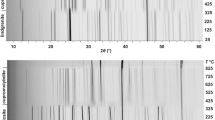Abstract
CuZr2(PO4)3 crystallises with the Nasicon-type structure and is a copper(I) ion conductor. The possibility of a solid solution between CuZr2(PO4)3 and Cu0.5Zr2(PO4)3 has been a controversial issue for many years. As part of a continued study, CuZr2(PO4)3 and Cu0.5Zr2(PO4)3 were prepared by solid state methods and used to investigate the copper stoichiometry and phase relationships between these two materials as a function of copper content, temperature and oxygen fugacity. The following reversible reaction: Cu0.5Zr2(PO4)3 (s) + \(\frac{1}{2}\)CuO (s) ↔ CuZr2(PO4)3 (s) + \(\frac{1}{4}\)O2(g) was studied by thermogravimetry in an atmosphere of PO2 = 0.22 atm and was found to occur at 475 ± 10°C. Thus, CuZr2(PO4)3 is a thermodynamically stable phase in air above ∼475°C, which places a lower temperature limit on its use as an electrolyte in air. The results of X-ray powder diffractometry on materials with various copper contents that had been annealed in argon at 750°C indicate that there is no evidence for a significant solid solution between CuZr2(PO4)3 and Cu0.5Zr2(PO4)3 nor, a reductive decomposition of Cu0.5Zr2(PO4)3. The coexistence of CuZr2(PO4)3 and Cu0.5Zr2(PO4)3 as discrete phases is also supported by evidence from electron spin resonance spectroscopy on these materials, which indicate the presence of copper(II) ions in CuZr2(PO4)3 at a dopant and dispersed level of concentration. The results from energy dispersive X-ray analysis, as well as, the novel use of the fluorescent behaviour of CuZr2(PO4)3 in ultra-violet light as an analytical tool, support the above conclusions.
Similar content being viewed by others
References
H. Y.-P. HONG, Mat. Res. Bull. 11 (1976) 173.
P. C. YAO and D. J. FRAY, Solid State Ionics 8 (1983) 35.
I. BUSSEREAU, M. S. BELKHIRIA, P. GRAVEREAU, A. BOIREAU, J. L. SOUBEYROUX, R. OLAZCUAGAL and G. LE FLEM, Acta Cryst. C48 (1992) 1741.
E. FARGIN, I. BUSSEREAU, G. LE FLEM, R. OLAZCUAGAL, C. CARTIER and H. DEXPERT, Eur. J. Solid State Inorg. Chem. 29 (1992) 975.
E. FARGIN, I. BUSSEREAN, R. OLAZCUAGAL and G. LE FLEM, J. Solid State Chem. 112 (1994) 176.
B. MAIHOLD and H. WULFF, Wiss Z. Ernst-Moritz-Arndt-Uni. Greifswald, Math.-nat.wiss. Reihe 36 (1987) 27.
G. LE POLLES, C. PARENT, R. OLAZCUAGAL, G. LE FLEM and P. HAGENMULLER, C. R. Acad, Sci. Paris 306 Série II (1988) 765.
A. EL JAZOULI, M. ALAMI, R. BROCHU, J. M. DANCE, G. LE FLEM and P. HAGENMULLER, J. Solid State Chem. 71 (1987) 444.
I. BUSSEREAU, R. OLAZCUAGAL, G. LE FLEM and P. HAGENMULLER, Eur. J. Solid State Inorg. Chem 26 (1989) 383.
E. CHRISTENSEN, J. H. VON BARNER, J. ENGELL and N. J. BJERRUM, J. Mater. Sci. 25 (1990) 4060.
I. TAOUFIK, M. HADDAD, A. NADIRI, R. BROCHU and R. BERGER, J. Phys. Chem. Solids 60 (1999) 701.
T. E. WARNER and J. MAIER, Mat. Sci. Eng. B 23 (1994) 88.
R. J. SCHAFFER, PhD Thesis, The University of Leeds (1998).
A. J. DAVIDSON and D. J. FRAY, Solid State Ionics 136–137 (2000) 613.
T. E. WARNER, P. P. EDWARDS and D. J. FRAY, Mat. Sci. Eng. B 8 (1991) 219.
R. J. SCHAFFER, R. V. KUMAR and A. E. INGHAM, Mat. Res. Bull. 34 (1999) 1153.
T. E. WARNER, W. MILIUS and J. MAIER, Ber. Bunsenges. Phys. Chem. 96 (1992) 1607.
R. AHMAMOUCH, S. ARSALANE, M. KACIMI and M. ZIYAD, Mat. Res. Bull. 32 (1997) 755.
A. SERGHINI, R. BROCHU, R. OLAZCUAGAL and P. GRAVEREAU, Mat. Lett. 22 (1995) 149.
Author information
Authors and Affiliations
Rights and permissions
About this article
Cite this article
Christiansen, R.HW., Warner, T.E. A study of copper stoichiometry and phase relationships in the copper-zirconium phosphate system: CuZr2(PO4)3 – Cu0.5Zr2(PO4)3 . J Mater Sci 41, 1197–1205 (2006). https://doi.org/10.1007/s10853-005-3657-1
Received:
Accepted:
Published:
Issue Date:
DOI: https://doi.org/10.1007/s10853-005-3657-1




